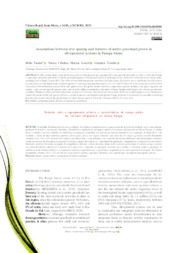Publicações
Associations between tree spacing and features of native grassland grown in silvopastoral systems in Pampa biome.
Autoria: TONINI, H.; GENRO, T. C. M.; TRENTIN, G.
Resumo: The current study assessed the association of eucalyptus-tree spacing with forest growth and yield, as well as with the floristic composition, diversity and yield of natural grassland grown in silvopastoral systems in Pampa biome. Data were collected in six family cattle- ranching area in Bagé County (RS). The effect of two different genetic materials (seminal-origin Eucalyptus dunnii plant and one Eucalyptus grandis clone) on shading features of plants grown in 3 planting-spacing dimensions (625, 312 and 208 trees ha-1) was assessed, as well as their association with herbaceous extract (bare soil; green cover; forage dry matter; floristic composition; species richness; and grass, legumes and winter - and summer-growth species rates) and forestry (litter accumulation, diameter at breast height, total height and volume per hectare) variables. Planting carried out at the highest tree density (625 trees ha-1) has increased forest yield. However, it reduced green cover, herbaceous extract dry-matter yield and species richness, mainly in grasses and legumes with greater forage potential. Conversely, it is possible combining forestry and animal yield to the preservation of native forage species at low tree densities (204 to 312 trees ha-1).
Ano de publicação: 2024
Tipo de publicação: Artigo de periódico
Unidade: Embrapa Pecuária Sul
Palavras-chave: Campo, Composição Botânica, Eucalipto, Pastagem Nativa

